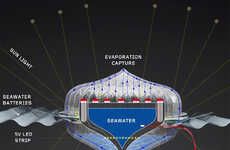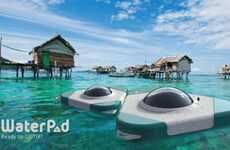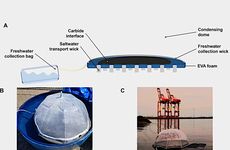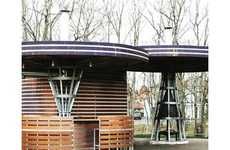
Nanotech Sand Preserves Water
Michael Plishka — February 18, 2009 — Eco
References: xpress4me
The image of water flowing through one’s fingers like sand is a powerful image for those in parched desert lands. Water is valuable and the inability to hold onto it can drive one to tears.
However, thanks to a new nanotechnology, sand will no longer be used as a metaphor for loss of water.
By treating the surface of each particle of sand with a special nano-coating, the sand is rendered hydrophobic -- it repels water.
The result is that instead of water running through the sand, the sand actually forms a barrier to water and prevents its penetration.
By layering this sand beneath top soils, water is saved and forms a reservoir from which the roots of plants can drink - even in a desert.
In test fields on the Arab Peninsula, the super-sand is showing great promise. With new hydrophobic sand in place, traditional watering of desert plants five or six times a day can be reduced to one watering, saving 75 per cent more water, a precious resource that is dwindling across the Arab Peninsula.
However, thanks to a new nanotechnology, sand will no longer be used as a metaphor for loss of water.
By treating the surface of each particle of sand with a special nano-coating, the sand is rendered hydrophobic -- it repels water.
The result is that instead of water running through the sand, the sand actually forms a barrier to water and prevents its penetration.
By layering this sand beneath top soils, water is saved and forms a reservoir from which the roots of plants can drink - even in a desert.
In test fields on the Arab Peninsula, the super-sand is showing great promise. With new hydrophobic sand in place, traditional watering of desert plants five or six times a day can be reduced to one watering, saving 75 per cent more water, a precious resource that is dwindling across the Arab Peninsula.
Trend Themes
1. Hydrophobic Sand - The development and use of hydrophobic sand as a water-saving solution presents an opportunity for sustainable agriculture in arid regions.
2. Nanotechnology - Advancements in nanotechnology enable the coating of sand particles, offering innovative solutions for water conservation.
3. Water-saving Techniques - The implementation of water-saving techniques, such as hydrophobic sand, can address the challenge of water scarcity in desert environments.
Industry Implications
1. Agriculture - The agriculture industry can explore the use of hydrophobic sand to improve water efficiency and enable sustainable farming practices in arid regions.
2. Nanotechnology - The nanotechnology industry can leverage advancements in nano-coating to create innovative solutions for various sectors, including water conservation.
3. Water Management - The water management industry can adopt and integrate hydrophobic sand as a disruptive innovation to optimize water usage and mitigate water scarcity challenges.
2
Score
Popularity
Activity
Freshness























